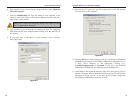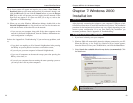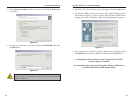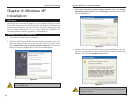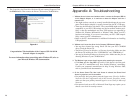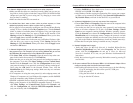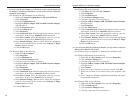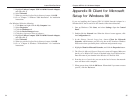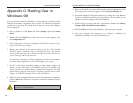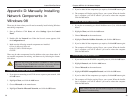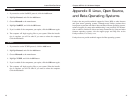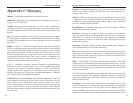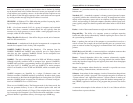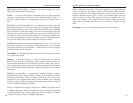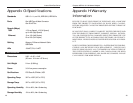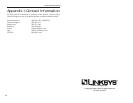
Compact USB 2.0 10/100 Network Adapter
UTP - Unshielded twisted pair is the most common kind of copper telephone
wiring. Twisted pair is the ordinary copper wire that connects home and many
business computers to the telephone company. To reduce crosstalk or electro-
magnetic induction between pairs of wires, two insulated copper wires are
twisted around each other. Each signal on twisted pair requires both wires.
Since some telephone sets or desktop locations require multiple connections,
twisted pair is sometimes installed in two or more pairs, all within a single
cable.
Workgroup - Two or more individuals that share files and databases.
47
Instant EtherFast
®
Series
46
STP (Shielded Twisted Pair) - Telephone wire that is wrapped in a metal
sheath to eliminate external interference.
Switch - 1. A data switch connects computing devices to host computers,
allowing a large number of devices to share a limited number of ports. 2. A
device for making, breaking, or changing the connections in an electrical cir-
cuit.
TCP (Transmission Control Protocol) - A method (protocol) used along with
the IP (Internet Protocol) to send data in the form of message units (datagram)
between network devices over a LAN or WAN. While IP takes care of handling
the actual delivery of the data (routing), TCP takes care of keeping track of the
individual units of data (called packets) that a message is divided into for effi-
cient delivery over the network. TCP is known as a "connection oriented" pro-
tocol due to requiring the receiver of a packet to return an acknowledgment of
receipt to the sender of the packet resulting in transmission control.
TCP/IP (Transmission Control Protocol/Internet Protocol) - The basic com-
munication language or set of protocols for communications over a network
(developed specifically for the Internet). TCP/IP defines a suite or group of
protocols and not only TCP and IP.
Throughput - The amount of data moved successfully from one place to anoth-
er in a given time period.
Topology - A network's topology is a logical characterization of how the
devices on the network are connected and the distances between them. The
most common network devices include hubs, switches, routers, and gateways.
Most large networks contain several levels of interconnection, the most impor-
tant of which include edge connections, backbone connections, and wide-area
connections.
USB (Universal Serial Bus) - A “plug-and-play” interface between a computer
and peripherals, such as digital cameras, scanners, game controllers, speakers,
keyboards, portable data storage, or printers. With USB, you can add a new
peripheral to your computer without having to add an adapter card or powering
down the computer. USB also supports hot-swapping, the addition or removal
of devices while the computer is running.
USB 1.1-compliant devices support data rates of 1.5Mbps (low-speed) and up
to 12Mbps (full-speed). USB 2.0-compliant devices are backward compatible
with earlier USB devices, and they support data rates of 1.5Mbps (low-speed),
12Mbps (full-speed), and up to 480Mbps (high-speed).



